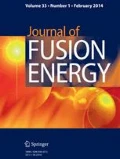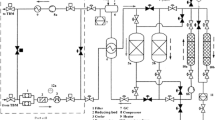Abstract
ITER is the first worldwide international experimental nuclear fusion facility, which aims to prove the physics and technological basis for future fusion power plants. As main stages of ITER technical risk control, the reliability, availability, maintainability and inspectability (RAMI) approach should be applied to all ITER components during their design phase to reduce potential technical risks. Test blanket modules play a key role in ITER. Helium cooled ceramic breeder (HCCB) TBM is one of TBM concepts which were proposed by China. HCCB TBM and its ancillary system are called HCCB test blanket system (TBS). The RAMI analysis was performed on the conceptual design of the ITER HCCB TBS in this paper. A functional breakdown was prepared in a bottom-up approach, resulting in the system being divided into 3 main functions, 1 support function, 14 sub-functions and 50 basic functions. These functions were described using the IDEF0 method. Reliability block diagrams were prepared to estimate the reliability and availability of each function under the stipulated operating conditions. The inherent availability of the HCCB TBS expected after implementation of mitigation actions was calculated to be 94.69 % over 2 years. A failure modes, effects and criticality analysis was performed with criticality charts highlighting the risk level of the different failure modes with regard to their probability of occurrence and their effects on the availability.









Similar content being viewed by others
References
J.N. Holtkamp, An overview of the ITER project. Fusion Eng. Des. 82, 427–434 (2007)
D. van Houtte, K. Okayama, F. Sagot, RAMI approach for ITER. Fusion Eng. Des. 85, 1220–1224 (2010)
S. Kitazawa, K. Okayama, Y. Neyatani et al., RAMI analysis of ITER CODAC. Fusion Eng. Des. 87, 1510–1513 (2012)
Y. Wu, FDS Team, Conceptual design activities of FDS series fusion power plants in China. Fusion Eng. Des. 81(23–24), 2713–2718 (2006)
Y. Wu, FDS Team, Conceptual design, testing strategy of a dual functional lithium lead test blanket module for ITER and EAST. Nucl. Fusion 47, 1533–1539 (2007)
Y. Wu, FDS Team, Conceptual design activities of FDS series fusion power plants in China. Fusion Eng. Des. 81, 2713–2718 (2006)
Y. Wu, FDS Team, Conceptual design of the china fusion power plant FDS-II. Fusion Eng. Des. 83(10–12), 1683–1689 (2008)
Q. Huang, C. Li, Y. Li et al., Progress in development of China low activation martensitic steel for fusion application. J. Nucl. Mater. 367–370, 142–146 (2007)
Y. Wu, Q. Huang, Z. Zhu et al., R&D of dragon series lithium lead loops for material and blanket technology testing. Fusion Sci. Technol. 62, 272–275 (2012)
Y. Wu, Design status and development strategy of China liquid lithium–lead blankets and related material technology. J. Nucl. Mater. 367–370, 1410–1415 (2007)
Y. Wu, J. Qian, J. Yu, The fusion-driven hybrid system and its material selection. J. Nucl. Mater. 307–311, 1629–1636 (2002)
Y. Wu, J. Jiang, M. Wang, M. Jin et al., A fusion-driven subcritical system concept based on viable technologies. Nucl. Fusion 51, 103036 (2011)
L. Hu, R. Yuan, H. Chen et al., Failure modes and effects analysis on ITER DFLL-TBM system. Fusion Eng. Des. 87, 1307–1309 (2012)
D. van Houtte, K. Okayama, F. Sagot, ITER operational availability and fluence objectives. Fusion Eng. Des. 86, 680–683 (2011)
Component reliability data for use in probabilistic safety assessment, IAEA-TECDOC-478, 1988
Cadwallader LC, Selected component failure rate values from fusion safety assessment tasks, INEEL/EXT-98-00892, 1998
Abdou M, Next steps for realizing fusion power and comparative analysis of roadmaps of word major fusion programs. TOFF 2012 ANS 20th topical meeting on the technology of fusion energy (Nashville, TN, 2012)
Acknowledgments
This work was supported by the Strategic Priority Research Program of Chinese Academy of Sciences (No. XDA03040000), the National Special Program for ITER (Nos. 2014GB112001 and 2014GB116000), the Informatizational Special Projects of Chinese Academy of Sciences (No. XXH12504-1-09), and the Foundation of President of Hefei Institutes of Physical Science (No. YZJJ201327). The author expresses his appreciation and gratitude for the other members of FDS team. Thanks for their contributed to this work.
Author information
Authors and Affiliations
Corresponding author
Rights and permissions
About this article
Cite this article
Wang, D., Wang, J., Yuan, R. et al. RAMI Analysis of HCCB TBS for ITER. J Fusion Energ 34, 1094–1099 (2015). https://doi.org/10.1007/s10894-015-9913-8
Published:
Issue Date:
DOI: https://doi.org/10.1007/s10894-015-9913-8




